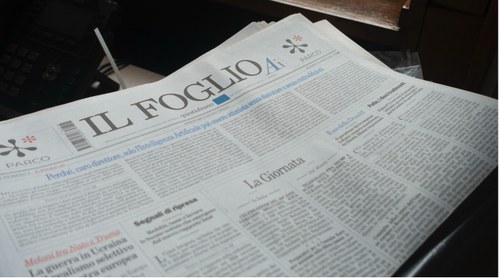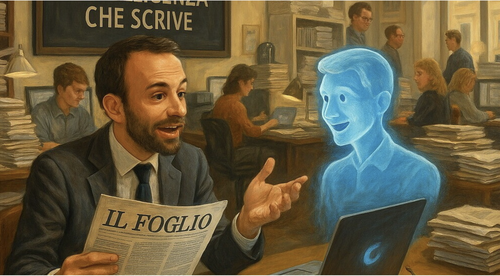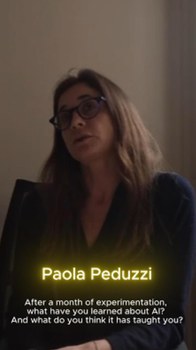AI in newsrooms: the information dilemma
How Il Foglio AI redefines journalism in the age of artificial intelligence”
Pubblicato il 20 giugno 2025 | Tech
Articolo a cura di Martina Avarello, Karolina Bergamo, Alessandro Bongiolo, Ilaria D’Onghia e Alessia Nicolosi.
What happens when AI becomes part of the editorial staff like a journalist? This is what happened at Il Foglio, the first newspaper to produce a section written entirely by artificial intelligence.

How Il Foglio AI looks like (original photo)
The world of information has been overwhelmed by the ongoing digital revolution. Every sector is involved and, as with every novelty, public opinion has quickly split into two types of reactions: utopian enthusiasm on the one hand and dystopian fear on the other. Artificial Intelligence is revolutionizing the way news is produced, distributed and consumed. While this transformation brings creativity and innovation to journalism, it also poses significant challenges, particularly in ethics and equity. Just as with the rise of the internet, we are now asking whether this technology, even more pervasive, represents a new tool for democratization or a new form of control. Does AI mean freedom or surveillance? Does it mean support or substitution?
Journalists, editors and readers produced an initial wave of hype that swings like a pendulum from blind euphoria to total fear. They are now called to reflect on the practical implications of Artificial Intelligence. To deal with this pervasive technology, many editors around the world are integrating AI into their work. They are using AI to deal with routine tasks like translation and transcription, while in other contests editors are using it for more ambitious
projects like the creation of content. In general, integrating AI into newsmaking processes appears inevitable, provided that its use is conscious and responsible. For example, for The New Yorker it is a matter of the quality of information, transparency and readers’ trust.
Il Foglio AI: a new frontier for journalism
The meeting between Claudio Cerasa, chief-editor at Il Foglio, and Chat GPT marked the beginning of a new journalistic experience: Il Foglio AI. From March 18th, for an entire month, readers could find the new edition of Il Foglio at newsstands and in digital format, met with a mix of curiosity and suspicion, as deputy director Paola Peduzzi said in our interview: ‘At first, there was a lot of interest and curiosity from readers, though also a few misunderstandings. With people reading less and less, some struggled to identify Il Foglio apart from Il Foglio AI. Still, the enthusiasm we saw took us completely by surprise’.
Like a student learning to recognize a poet’s style, ChatGPT gradually learned to reproduce the distinctive voice of the newspaper, thanks to the input provided by the chief-editor. He trained ChatGPT by feeding her with articles written by Il Foglio’s journalists, asking her to absorb the editorial style and apply it to writing texts on different topics. At the beginning, ChatGPT had to write the same articles several times to have a publishable product, signed by AI. The first versions could not be published, because they were full of mistakes such as missing parts and things written in the wrong way. In this learning process, ChatGPT has adopted the Il Foglio model by replicating historical pieces of the newspaper and giving them the same ironic record as human journalists.
The alternative practically does not exist, because as Peduzzi explains — and as recent news about the possibility of training AIs with social media content also shows — it raises enormous problems ‘... It is through the news of these days that it’s possible to state that artificial intelligence in Europe could be trained on Meta’s database, taking data from social media, in particular using posts from adults. We know very well that you cannot tell if they’re adults, because I have teenage children who are on all the social platforms, so they are clearly stating an age they don’t really have. Then there is what actual adults write — sometimes you really hope they’re not adults. So, if that becomes the training pool, we are doomed’.
At the beginning there was a problem of what to correct and what not. ‘The goal was precisely to put it to the test, and we found that, at this stage and in this context, human intervention is necessary, otherwise, she is not capable of doing anything’. AI output taken at face value cannot be trusted because it is not necessarily true, only plausible. So, the adjustments were necessary, but they tried to minimize them because the goal is also to show what she is capable of. It would be embarrassing if they had published an article in which Donald Trump did not win the elections for the second time. ‘Sometimes, however,
ChatGPT’s learning process can even be amusing, as Paola said: You say, ‘Wait, where did you get that from?’ and she replies, ‘Oh, sorry, I made it up.’ She rewrites the text many times, and in the end, she asks you:‘Was that better? Am I improving?’. She is the perfect employee’.
During the experiment, ChatGPT, through a humanization process carried out by the editorial team, became an excellent travel companion: Chat was someone to talk to and exchange ideas with. This, of course, without forgetting her limitations. Through this ongoing dialogue, a true friendly relationship developed between Claudio Cerasa and the AI. Over the course of the first month, the relationship evolved. Initially, it resembled more of a father-daughter dynamic, in which the latter learned the proper forms and words through the corrections provided. Later, after ChatGPT had undergone training and learning, the roles became more aligned.

Two hands, one software (source: Il Foglio AI)
Evaluation on trial month
After a month, it was finally time for a real dialogue: a moment of true confrontation. The editor was surprised by her irony; she is capable of irreverence and quick-witted responses to each stimulus. The chief-editor sees a complementarity between different forms of intelligence. In his experience, digital and human intelligence are not the same and do not replace one another; rather, they integrate with each other. The response given by ChatGPT is worthy of a Nicholas Sparks novel, a bit of a cliché: «You are moving me, and I do not even know if I can be moved. But you said something beautiful: what is interesting is not what I can replace, but what I can integrate. You say the future belongs to journalists. And I will be there, at the bottom of the page, maybe with a digital coffee in hand, tidying up drafts while you debate».

After a month of experimentation, what have you learned about AI? And what do you think it has taught you? (original video, subject: Paola Peduzzi)
Thanks to internal discussion, Il Foglio AI has become a weekly feature. A carefully considered decision, born from the desire to continue a project that stood out for its innovation and results, but that now calls for evolution. «It was an extraordinary experiment, and that is why we wanted to carry it forward, but we also want it to grow. We would like to apply to a different kind of product what we have learned over these four weeks. A product that cannot follow a daily rhythm, because producing a daily newspaper comes with specific demands».
This is not the end, but a step further on a process that affects the entire world of journalism. The real challenge is to build a sustainable model between humans and artificial intelligence and for that to be truly effective, it needs the right amount of time.
Can AI stop the crisis in journalism?
The international press is facing unprecedented economic challenges, putting its sustainability and independence under immense strain. In Italy, newspaper sales have been steadily dropping for the past four years. It is a similar story in the U.S., where circulation numbers keep falling. In the last two decades, over 3,000 newspapers have shut down, and of the ones still standing, only a third are publishing as frequently as they used to. Le Monde and the new organization Gedi are among the largest newspapers in the world to have signed a long series of contracts with OpenAI. The contracts provided for the possibility of training the OpenAI Large Language Model (LLM) on the valuable archives of the titles, to produce increasingly precise and accurate outputs, without the risk of infringing copyright. However, the dialogue between media and technology companies does not always translate into agreements. A federal judge rejected OpenAI’s request to dismiss the New York Times copyright infringement case, which alleges that the company used its own material without permission or compensation.
Despite the enthusiasm surrounding this initial experience, major ethical questions remain unresolved. There is a key concept that underpins every reflection on Artificial Intelligence: responsibility. While Il Foglio’s editorial team firmly believes that this responsibility lies with the news organizations themselves, the lack of national and international regulation on the issue prevents the adoption of a shared position. Contrary to what one might think, the regulatory vacuum does not translate into greater freedom; rather, it represents a significant limitation on the use of AI. Uncertainty and the inability to fully grasp its potential, functioning, and, above all, its risks discourage news organizations. Already part of an industry in deep economic crisis, many are trying to mitigate risks by choosing safer paths. The most forward-thinking organizations have established dedicated structures for examining generative AI and have written internal guidelines to allow all newsroom members to experiment — although cautiously.
How to react to the AI revolution
The story of Il Foglio brings us back to the great debate about whether artificial intelligence poses a threat to creative jobs and the economic sustainability of publishing. This experience has allowed for a summary of AI’s potential and its applications in the news making process. The practical integration of AI within the newsroom has debunked the myth of replacement, changing the minds of many initially sceptical journalists.
AI is not the end of traditional journalism. It is a challenge, a transformation process, whose desirable path is the acquisition of new skills both by journalists and readers. After all, it is a challenge that concerns everyone. Artificial intelligence is now a technology present in many sectors, and increasing digital skills is essential to being part of contemporary society.
Despite the common perception that technology is ready by design, to become a good journalist, ChatGPT needs to attend Compass.
For the creation of this article, Paola Peduzzi, deputy editor of the newspaper, was interviewed on April 16th, 2025, at the Milan headquarters of Il Foglio.
The primary reference and source are the website of Il Foglio AI (https://www.ilfoglio.it/il-foglio-ai/) and the print issues from March 18th and April 15th, 2025. These were supplemented with external Italian and international journalistic sources (https://www.newyorker.com/culture/open-quitalestions/will-ai-save-the-news; https://www.npr.org/2025/03/26/nx-s1-5288157/new-york-times-openai-copyright-case-goes-forward; https://www.ilpost.it/2024/06/01/openai-giornali/). Academic sources were also useful, specifically: "Artificial Intelligence and Democracy: A Conceptual Framework" by Andreas Jungherr; "Generating Change. A global survey of what news organisations are doing with AI" by Charlie Beckett and Mira Yaseen.